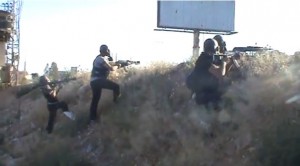Syria’s President Bashar al-Assad’s stepped up military efforts – new Russian anti-aircraft missiles; imported fighters from Lebanon and Iran; and lately, increased use of chemical weapons – are having their desired effect. Today, Syria‘s main opposition group announced it will not take part in peace talks even as the regime appears to be gaining in military strength.

Particularly disturbing are reports of the Assad regime’s increased use of chemical weapons. Since March, the trickle of reports has become a flash flood. What’s now clear is that Mr. Assad, absent outside intervention, is willing to make the use of unconventional weapons more conventional as he seeks to end his government’s military stalemate with rebels.
On May 26, rebel fighters and civilians in the Damascus suburbs of Harasta, Qaboun, and Jobar reported that numerous residents suffered from respiratory problems, nausea, and other symptoms of chemical nerve agents. Three people were reportedly killed in the suspected attack while at least 70 others were reported injured. Recently-posted video footage from the area portrayed both Syrian rebels and military troops fighting with gas masks.
On May 16, British media sources claimed to have verified footage of an April 29 chemical weapons attack in the town of Saraqeb. Two canisters were reportedly dropped from government helicopters, releasing gases that caused similar symptoms among residents.
On May 26, French journalists released footage taken on April 13 showing a chemical attack on Syrian rebel positions in the Damascus suburb of Jobar. The footage and other evidence have been passed to French intelligence, which has stated that it will issue a confirmation of the reports in the coming days. The Assad regime denies using chemical weapons.
Currently, the majority of the attacks have been reported in strategic Damascus suburbs being contested by rebels, each of which allows access to either the center of the city or main highways. Other attacks have been reported in the cities of Aleppo and Homs, which are also considered to be highly valuable by the Assad regime.
Combined, these continuous attacks paint a disturbing picture. Assad has resorted to limited, localized attacks using chemical weapon variants in key fronts in the conflict to achieve a far greater strategic goal as his forces gear to launch a major offensive to rid the Damascus suburbs of rebel presence in the coming weeks.
The use of such weapons in a sporadic fashion is an attempt by the Assad regime to offset an ongoing stalemate in the Damascus area, which has remained in place since a rebel advance during the summer of 2012. The Assad regime has since been unable to force a retreat of rebel militias using ground forces or heavy artillery bombardments, although they have prevented them from advancing into the capital’s center.
The regime’s reported escalation into chemical weapons usage follows a similar procedure used to introduce heavy artillery bombardments and air power at earlier stages of the conflict.
Before employing wide-scale artillery bombardments, the Assad regime tested the international community’s reaction by using the tactic in a single instance. The 2012 assault of the Baba Amr district in the city of Homs looks to have been its test case. After the unprecedented use of heavy artillery in Baba Amr did not result in international intervention, the Assad regime began to employ the tactic across the country. The introduction of air power and long-range missiles into the conflict was done in a similar escalatory fashion.
The apparent use of chemical weapons is now meant to demoralize rebel fighters, while deterring local populations from hosting them. Currently, chemical weapons attacks appear to have caused relatively few casualties when compared to heavy artillery bombardments, massacres perpetrated by irregular militias, and long-range missile attacks.
The low death tolls are likely due to the modification of existing chemical weapons in the Assad regime’s stockpile. The Syrian military has vast knowledge in mixing and modifying these materials and likely adjusted its stockpiles of sarin and other nerve agents to reduce their lethality.
Further, these chemicals have been modified to be mounted on simple weapons such as crude, short-range rockets – weapons that are also used by rebels. This tactic may have worked in the regime’s favor when it blamed rebels in Aleppo for a chemical attack on the Khan al-Assal neighborhood in March.
By modifying chemical weapons banned under existing treaties, the Assad regime would be able to blur the “red lines” designated by the international community regarding their use. The effectiveness of this strategy has been highlighted by recent equivocal statements by the Obama administration, which showed the administration’s hesitancy to intervene militarily as a response to recent claims of chemical weapons usage.
On the ground meanwhile, the reported stepped-up use of chemical weapons has increased anxiety among the rebels and sympathetic civilians, primarily due to concerns that the international community will not intervene on their behalf. Such sentiments will only work against long-term Western interests by fueling radicalization among moderate rebel supporters, and push both sides farther from a negotiating table.
It seems that the Syrian regime has become emboldened to use chemical weapons in a limited, albeit highly effective fashion. The silence of the West speaks volumes to Assad’s Russian, Iranian, and Hezbollah allies who continue to provide the military, economic, and financial support that is ultimately keeping his regime afloat.
One can only hope that the regime’s confidence in its ability to use chemical weapons with impunity will backfire. The recent lifting of the European Union’s arms embargo against Syria is a start. It sends an important message to a regime that is banking on the notion that Western fears of aiding rebel jihadists will prevent intervention, even while the regime commits far more heinous terrorism against its own people.
Concerned about developments in Syria? Click here to receive ongoing alerts and analysis.
This article was originally published by a Max analyst in the Christian Science Monitor.